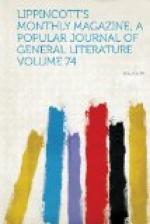a low door formerly closed by a single slab of travertine,
too ponderous for modern hinges. At first we
could distinguish nothing in the darkness, but by the
uncertain flaring of two candles, which the guide
waved about incessantly, we saw a chamber hewn in
the rock, with a roof in imitation of beams and rafters,
all of solid tufa stone. A low stone seat against
the wall on each hand and a small hanging lamp were
all the furniture of this apartment, awful in its
emptiness and mystery. On every side there were
dark openings into cells whence came gleams of white,
indefinite forms: a great Gorgon’s head
gazed at us from the ceiling, and from the walls in
every direction started the crested heads and necks
of sculptured serpents. We entered one by one
the nine small grotto-like compartments which surround
the central cavern: the white shapes turned out
to be cinerary urns, enclosing the ashes of the three
thousand years dead Volumnii. Urns, as we understand
the word, they are not, but large caskets, some of
them alabaster, on whose lids recline male figures
draped and garlanded as for a feast: the faces
differ so much in feature and expression that one can
hardly doubt their being likenesses: the figures,
if erect, would be nearly two feet in height.
The sides of these little sarcophagi are covered with
bassi-rilievi, many of them finely executed:
the subjects are combats and that favorite theme the
boar-hunt of Kalydon; there was one which represented
the sacrifice of a child. The Medusa’s head,
as it is thought to be, recurs constantly, treated
with extraordinary power: we were divided among
ourselves whether it was Medusa or an Erinnys with
winged head. The sphinx appears several times:
there are four on the corners of an alabaster urn
in the shape of a temple, exquisite in form and features,
and exceedingly delicate in workmanship. Bulls’
heads, with garlands drooping between them, a well-known
ornament of antique altars, are among the decorations.
But far the most beautiful objects were the little
hanging figures, which seemed to have been lamps of
a green bronze color, though we were assured that
they are terra-cotta: they are male figures
of exquisite grace and beauty, with a lightness and
airiness commonly given to Mercury; but these had
large angel pinions on the shoulders, and none on
the head or feet. There was not a scholar in the
party, so we all returned unenlightened, but profoundly
interested and impressed, and with that delightful
sense of stimulated curiosity which is worth more
than all Eurekas. With the exception of a few
weapons and trinkets, which we saw at the museum, this
is all that remains of the mighty Etruscans, save
the shapes of the common red pottery which is spread
out wholesale in the open space opposite the cathedral
on market-days—the most graceful and useful
which could be devised, and which have not changed
their model since earlier days than the occupants
of those tombs could remember.




